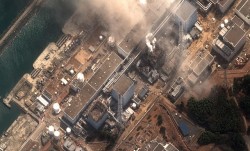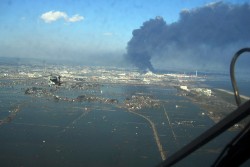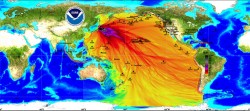 How much of a threat is the nuclear crisis in Japan? That question is on the minds of millions of people around the globe tonight. Unfortunately, the Japanese government and the mainstream media have both been doing their best to downplay this crisis. Even though there have been massive explosions at the Fukushima Dai-ichi nuclear facility, authorities in Japan have still been very stingy with information and they keep insisting that the situation is under control. But the situation is not under control. In fact, it just seems to get worse with each passing day. Radiation levels are now incredibly high at the Fukushima Dai-ichi complex and the radiation cloud is starting to spread. Radiation levels in Tokyo are already 10 times above normal levels, and there are reports in the international media that some people have begun to flee the city. It is imperative that the Japanese government tell the truth about what is going on because this could potentially affect the health of millions of people. There are over 12 million people in the city of Tokyo alone. If this nuclear crisis continues to get worse it could potentially end up killing more Japanese than the tsunami just did.
How much of a threat is the nuclear crisis in Japan? That question is on the minds of millions of people around the globe tonight. Unfortunately, the Japanese government and the mainstream media have both been doing their best to downplay this crisis. Even though there have been massive explosions at the Fukushima Dai-ichi nuclear facility, authorities in Japan have still been very stingy with information and they keep insisting that the situation is under control. But the situation is not under control. In fact, it just seems to get worse with each passing day. Radiation levels are now incredibly high at the Fukushima Dai-ichi complex and the radiation cloud is starting to spread. Radiation levels in Tokyo are already 10 times above normal levels, and there are reports in the international media that some people have begun to flee the city. It is imperative that the Japanese government tell the truth about what is going on because this could potentially affect the health of millions of people. There are over 12 million people in the city of Tokyo alone. If this nuclear crisis continues to get worse it could potentially end up killing more Japanese than the tsunami just did.
Yes, things really are that serious.
We are not just talking about a repeat of Chernobyl.
We are possibly talking about “many Chernobyls”.
It is somewhat understandable that the Japanese government and the mainstream media do not want to panic the public, but the reality is that people need the truth about what is going on.
Unfortunately, it is not likely that the Japanese government or the mainstream media are going to “change their stripes” overnight, so in order to try to get an idea of what is really going on we need to look at the clues.
Sometimes it is much more important to watch what people are doing rather than what they are saying.
For example, a significant number of foreign governments are now evacuating personnel from Tokyo.
Why would they be evacuating if there was no threat?
Posted below are 27 signs that the nuclear crisis in Japan is much worse than either the mainstream media or the Japanese government have been telling us. When you take all of these clues and you put them together it really does paint a frightening picture….
#1 Japanese Prime Minister Naoto Kan is urging all people living within 30 kilometers of the Fukushima Dai-ichi nuclear facility to stay indoors.
#2 Andre-Claude Lacoste, the head of France’s Nuclear Safety Authority, says that the containment vessel surrounding the No. 2 reactor at Japan’s Fukushima Dai-ichi nuclear complex is “no longer sealed“.
#3 Radiation levels in Tokyo are already 10 times above normal levels.
#4 Reuters is reporting that some residents of Tokyo are already starting to flee the city.
#5 Radiation levels in one city north of Tokyo, Utsunomiya, were recently reported to be 33 times above normal levels.
#6 Radiation levels in the city of Saitama have been reported to be 40 times above normal levels.
#7 According to Japanese Prime Minister Naoto Kan, the “possibility of further radioactive leakage is heightening.”
#8 The Japanese government is admitting that radiation levels near the Fukushima Dai-ichi complex are very harmful to human health.
#9 According to the World Nuclear Association, exposure to over 100 millisieverts of radiation a year can lead to cancer. At this point the level of radiation being measured right outside the number 4 reactor at the Fukushima Dai-ichi complex is 400 millisieverts per hour.
#10 A U.S. Navy crew that was assisting in relief efforts was exposed to a month’s worth of nuclear radiation in just a single hour.
#11 According to the U.S. Navy, low levels of radiation have been detected at their bases in Yokosuka and Atsugi.
#12 The USS Ronald Reagan recently detected significant levels of radiation 100 miles off the Japanese coast.
#13 The operator of the Fukushima Dai-ichi complex has pulled out 750 of the 800 workers that were working at the facility.
#14 The French embassy in Tokyo is advising French citizens to leave the city.
#15 The German embassy in Tokyo is advising all German citizens to leave the country entirely.
#16 German technology company SAP is evacuating their offices in Tokyo.
#17 Austria has announced that it is moving its embassy from Tokyo to Osaka due to fears about the radiation.
#18 Finland is urging all of their citizens to leave Tokyo.
#19 The Czech military is sending planes to Japan specifically to evacuate the Czech Philharmonic Orchestra.
#20 Air China is canceling many flights to Tokyo.
#21 The Chinese Embassy has announced that it will be evacuating all Chinese citizens from the Miyagi, Fukushima, Ibaraki and Iwate prefectures.
#22 Russia is making preparations to evacuate civilians and military units from the Kuril Islands.
#23 Physicist Frank von Hippel recently told the New York Times the following about this disaster: “It’s way past Three Mile Island already”.
#24 The president of France’s nuclear safety authority says that this crisis is now almost as bad as Chernobyl was….
“It’s clear we are at Level 6, that’s to say we’re at a level in between what happened at Three Mile Island and Chernobyl.”
#25 There have been reports of extremely high radiation at another nuclear facility in Japan. It has been reported that at the Onagawa nuclear plant radiation that is 700 times the normal level was detected at one point.
#26 One anonymous senior nuclear industry executive told The Times Of India that Japanese power industry managers are “basically in a full-scale panic” and that “they don’t know what to do”.
#27 It is also being reported that there were over 600,000 spent fuel rods stored at the Fukushima Dai-ichi complex. Most of these rods were apparently stored near the top of the 6 reactor buildings. There have already been major explosions at three of those buildings. It is now feared that there is now nothing to prevent many of these spent fuel rods from releasing radiation into the atmosphere. That is really, really bad news.
So is there a threat that nuclear radiation from Japan could reach the United States?
Well, actually everyone agrees that radiation could reach the United States. The controversy is whether or not it will be enough to be harmful to human health.
The Nuclear Regulatory Commission is admitting that it is “quite possible” that nuclear fallout from this disaster could reach the United States. In fact, Nuclear Regulatory Commission spokesman David McIntyre says that there could already be radiation from Japan over America….
Right now it’s quite possible that there could be some radiation floating over the United States.
But most government officials in the U.S. are insisting that there is “no threat” to the health of American citizens from this crisis at this point.
So how would nuclear radiation from Japan get transported to the United States?
Well, if radiation released by a damaged nuclear reactor got up into the jet stream, the first major land mass that it would encounter would be North America. In fact, the jet stream commonly takes air from over Japan directly over the west coast of the United States. The following video demonstrates this fact beautifully….
So is there any reason for those of us living in the United States to be concerned?
According to the Japanese government, the U.S. government and the mainstream media there is not.
But do you believe them?
The truth is that they seem much more concerned with keeping the public calm rather than telling the public the truth.
Radiation levels are increasing all over northern and central Japan. People are starting to leave Tokyo and other major cities in the region. Foreign governments are evacuating personnel. Fires continue to erupt at the Fukushima Dai-ichi complex. The authorities in Japan seem to have no idea how to solve this crisis.
If even one of those damaged nuclear reactors fully melts down it is going to be a complete and total nightmare. If you live in an area that could potentially be affected by nuclear radiation from Japan you might want to start figuring out how you and your family are going to handle this crisis.


